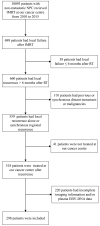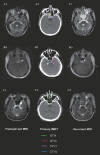Patterns and Prognosis of Local Recurrence of Nasopharyngeal Carcinoma after Intensity-modulated Radiotherapy
- PMID: 38169541
- PMCID: PMC10758024
- DOI: 10.7150/jca.88148
Patterns and Prognosis of Local Recurrence of Nasopharyngeal Carcinoma after Intensity-modulated Radiotherapy
Abstract
Objective: To investigate the patterns of local failure and prognosis in patients with locally recurrent nasopharyngeal carcinoma (rNPC) after primary intensity-modulated radiotherapy (IMRT). Methods: The data of 298 patients with locally rNPC after IMRT were retrospectively analyzed. Magnetic resonance images of the initial and recurrent tumors were reviewed and, for patients with extra-nasopharyngeal local recurrence, the gross tumor volume of local recurrence was transferred to the original IMRT plan for dosimetry analysis. Significant prognostic factors for overall survival (OS) were selected by multivariate Cox regression analysis. Results: The commonest recurrence sites were the nasopharynx (93%, 277/298) and skull base (53.7%, 160/298). Of the 21 patients with extra-nasopharyngeal recurrence (19 cases valid), 12 had in-field failures, 4 had marginal failures, and 3 had out-field failures. The ethmoid sinus (57.1%, 4/7) and nasal cavity (28.6%, 2/7) were the most frequent sites of marginal and out-field failures. After median follow-up of 37 months, the 3-year and estimated 5-year OS rates were 57.3% and 41.7%, respectively. Multivariate analysis showed that age, recurrence interval, plasma Epstein-Barr virus (EBV) DNA level, and recurrent T stage were independent prognostic factors for OS. Conclusions: Local failure after IMRT occurs most commonly in the nasopharynx and skull base. In patients with extra-nasopharyngeal recurrence, in-field failure remains the main failure pattern, and marginal and out-field failures mainly occur in the ethmoid sinus and nasal cavity. Elder age, shorter recurrence interval, detectable plasma EBV DNA, and advanced recurrent T stage are negative predictors of OS in patients with rNPC.
Keywords: IMRT; failure pattern; local recurrence; nasopharyngeal carcinoma; prognosis.
© The author(s).
Conflict of interest statement
Competing Interests: The authors have declared that no competing interest exists.
Figures




Similar articles
-
Patterns and prognosis of regional recurrence in nasopharyngeal carcinoma after intensity-modulated radiotherapy.Cancer Med. 2023 Jan;12(2):1399-1408. doi: 10.1002/cam4.5020. Epub 2022 Jul 13. Cancer Med. 2023. PMID: 35822664 Free PMC article.
-
Prognostic value of gross tumor regression and plasma Epstein Barr Virus DNA levels at the end of intensity-modulated radiation therapy in patients with nasopharyngeal carcinoma.Radiother Oncol. 2019 Mar;132:223-229. doi: 10.1016/j.radonc.2018.10.010. Epub 2018 Oct 23. Radiother Oncol. 2019. PMID: 30366725
-
Initial experience using intensity-modulated radiotherapy for recurrent nasopharyngeal carcinoma.Int J Radiat Oncol Biol Phys. 2004 Mar 1;58(3):682-7. doi: 10.1016/S0360-3016(03)01508-6. Int J Radiat Oncol Biol Phys. 2004. PMID: 14967420
-
Local failure patterns for patients with nasopharyngeal carcinoma after intensity-modulated radiotherapy.Radiat Oncol. 2014 Mar 27;9:87. doi: 10.1186/1748-717X-9-87. Radiat Oncol. 2014. PMID: 24674015 Free PMC article.
-
Establishment of prognostic factors in recurrent nasopharyngeal carcinoma patients who received salvage intensity-modulated radiotherapy: A meta-analysis.Oral Oncol. 2018 Jun;81:81-88. doi: 10.1016/j.oraloncology.2018.04.017. Epub 2018 May 2. Oral Oncol. 2018. PMID: 29884418 Review.
Cited by
-
Patterns of failure and prognosis in nasopharyngeal carcinoma according to Epstein-Barr virus DNA status.Infect Agent Cancer. 2025 Feb 4;20(1):6. doi: 10.1186/s13027-024-00631-1. Infect Agent Cancer. 2025. PMID: 39905518 Free PMC article.
References
-
- Chen YP, Chan ATC, Le QT, Blanchard P, Sun Y, Ma J. Nasopharyngeal carcinoma. Lancet. 2019;394(10192):64–80. - PubMed
-
- Zhang B, Mo Z, Du W, Wang Y, Liu L, Wei Y. Intensity-modulated radiation therapy versus 2D-RT or 3D-CRT for the treatment of nasopharyngeal carcinoma: A systematic review and meta-analysis. Oral Oncol. 2015;51(11):1041–6. - PubMed
-
- Au KH, Ngan RKC, Ng AWY, Poon DMC, Ng WT, Yuen KT. et al. Treatment outcomes of nasopharyngeal carcinoma in modern era after intensity modulated radiotherapy (IMRT) in Hong Kong: A report of 3328 patients (HKNPCSG 1301 study) Oral Oncol. 2018;77:16–21. - PubMed
-
- Ng WT, Lee MC, Hung WM, Choi CW, Lee KC, Chan OS. et al. Clinical outcomes and patterns of failure after intensity-modulated radiotherapy for nasopharyngeal carcinoma. Int J Radiat Oncol Biol Phys. 2011;79(2):420–8. - PubMed
LinkOut - more resources
Full Text Sources

